|
MAX Hacks: For those who like to experiment
No matter how much thought goes into design, there's always that "what if" wonder that drives experimentation. The MAX Audio Processor is based far more on "should" than "can" when it comes to performance, but as a kit with all common through-hole components and a modular design, it's also a great platform for total customization for those who want something unique of their own.
In this section we remove our narrow ties and put down the slide rules, and in a striking departure from better judgement, we offer the following for those less interested in "well behaved" and more interested in "off the leash". Proceed with caution...
Changing the pre-emphasis (MAX 540 and 540L)
| The MAX Audio Processor utilizes an active pre-emphasis circuit which not only counteracts the upper voice frequency rolloff of many receivers but also provides boost to frequencies that are most important for clarity and intelligibility. The boost curve is determined by the values of R24. The default value of 15k provides a high frequency boost that begins to increase the voice energy just below 1kHz and providing up to 14dB of gain thoughout the presence frequencies. Decreasing the value of resistance will increase the maximum gain although this should be done carefully. The recommended minimum value for R24 is 4.7k.
Note that C29 (150pF) is used for limiting or "shelving" the boost so that it doesn't continue to increase above 10 kHz. This is important in order to maximize modulation levels which could otherwise be impacted by harmonic energy beyond the vocal range. |

|
Changing the pre-emphasis (MAX 530 and earlier)
| The MAX Audio Processor utilizes an active pre-emphasis circuit which not only counteracts the upper voice frequency rolloff of many receivers but also provides boost to frequencies that are most important for clarity and intelligibility. The boost curve is determined by the values of C93A and R94. The default values of 0.02uF and 15k result in a 300uS pre-emphasis curve (0.02 * 15,000 = 300) which begins to increase the voice energy just below 1kHz. Increasing the value of capacitance will lower the frequency where the boost begins while decreasing the value of capacitance will raise the frequency where the boost begins. A spare position on the board marked "C93B" has been provided to allow an additional capacitor to be installed in parallel to C93A if desired. |
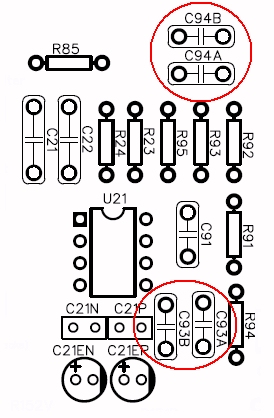
|
| In addition to pre-emphasis, there is also a provision for limiting or "shelving" the boost using the combination of C94A and R95 which act together as a low-pass filter. This is important in order to maximize modulation levels which could otherwise be impacted by harmonic energy beyond the vocal range. There isn't much benefit to changing the value of C94 from the default, but if you do, a spare position on the board marked "C94B" has been provided to allow an additional capacitor to be installed in parallel to C94A if desired. |
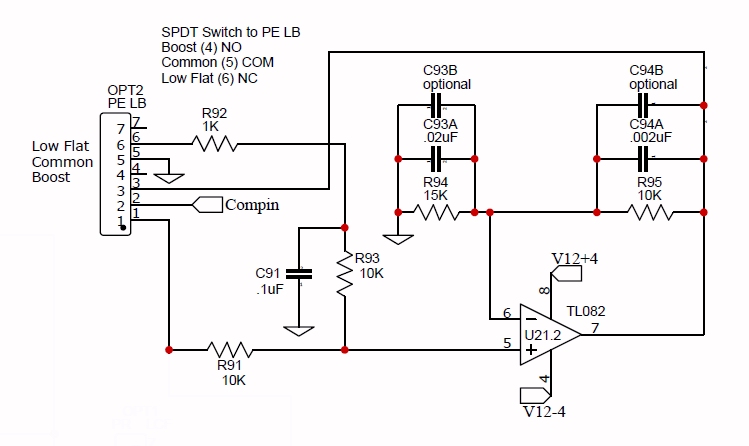
|
Increasing loudness
| One of the design considerations for the MAX Audio Processor is to achieve an optimal balance between "loud" and "clean", but this can be very subjective and some users may want a greater emphasis on "loudness". The next two methods can be used to emphasize loudness.
|
| 1) Compression ratio reduction (All models)
Changing the value of R101 from 20k to 10k results in greater "punch" by lowering the compression ratio and shifting more of the audio level management from the compressor to the limiter. The location of R101 will vary slightly depending on the model but should be close to the left edge of the circuit board near U101.
|
|
2) Increasing limiter drive level (500 only. Added as selectable feature to versions 510 and up)
Accomplishing this is as simple as increasing the drive level to the limiter circuit by replacing C101 with a resistor. Note that C102 would also be replaced with a resistor if you are using D102 for FM transmission (see the section on Half-cycle gain reduction control below). This modification has the effect of lowering the amount of compressor gain reduction which results in a higher drive level to the peak limiter circuit and thus increases loudness.
We've found that a 4.7k resistance noticeably increases loudness while still sounding clean. Higher value resistances such as 10k and up will further increase loudness with a corresponding sacrifice in fidelity. It will be necessary to readjust the output levels after this modification. Adding a 10k potentiometer or trimpot will allow fine adjustment.
|
|
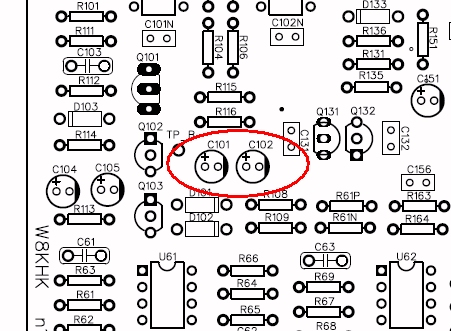
|
| In case you're wondering why a capacitor can be replaced with a resistor, the explanation is simple: C101 and C102 are not needed for D.C. blocking so they can be jumpered out anyway.
|
| 3) Supplemental negative peak limiting (MAX 540 & 540L)
While the peak limiter circuit provides the same degree of peak control found in broadcast processors, some users may want even tighter control over negative peaks or to put a greater emphasis on loudness. The adjustment requires the connection of a digital voltmeter between the emitter of Q135 and ground (chassis). The emitter is the lead closest to the letter "N" of "Neg Peak Lim".
|
| Trimpot R140 "Neg Peak Lim" is used to adjust the supplemental negative peak limiting and should provide an approximate adjustment range from -2.57V (full clockwise/disabled) down to -0.24V (full counterclockwise/heavy negative limiting with asymmetry). The test circuit shown here is the most accurate means to measure the negative limiting level by connecting point "A" to the - terminal and point "B" to the + terminal of one of the processor outputs. A digital voltmeter should be used for detecting small changes.
|

|
| With a 400Hz tone as the source and the input gain set just above the point where the PEAK LED illuminates, the output should be set to produce a reference 1.000V on the digital voltmeter. Starting with R140 set to full clockwise, rotate the trimpot setting counterclockwise until the first sign of a drop in negative output is noted on the digital voltmeter. This should occur with a Q135 emitter voltage of approximately -0.84V.
IMPORTANT NOTE: This function is intended to supplement the fixed negative peak limiter by using a setting that enhances the negative peak control. Using more aggressive settings (lower voltage measured at the emitter of Q135) will cause asymmetry by surpassing the fixed negative limiting action.
|
Dynamic noise reduction (All models)
As a clarification, this is different from the Dynamic Processing feature that was added beginning with the MAX 500. That function freezes the gain during pauses in speech which prevents background noise from being unnecessarily amplified. However, when the Dynamic Processor is disabled, the gain will increase dramatically at a rate set by the Density switch.
This modification decreases the high frequency gain during pauses which not only can help prevent feedback from monitor speakers or even headphones, but also reduces background noise. The addition of a 0.0047uF ("472") mylar cap in the C106 position (MAX 540 and 540L), or the R110 position (MAX 500) will add a high a frequency rolloff that increases with gain. This doesn't affect audio as long as the NORM indicator is active but will greatly reduce broadband noise pickup during pauses.
| Users with MAX 510 through 530 processors and some versions of the 540 and 540L will need to solder this capacitor under the circuit board with one lead at the junction of R101 and U101 pin 3 and the other lead to the grounded lead of R102. Sorry for the inconvenience, this is a new idea...
|

|
Half-cycle gain reduction control (500 only. Added as selectable feature to versions 510 and up)
This isn't so much of a hack, but rather, a description of the difference between using both halves of the audio waveform to control gain reduction (compression) compared to using just one half. First, it's important to point out that this is *not* a mod to do if you use your MAX for FM transmission, a mode that benefits the most from symmetric deviation (modulation). However, half-cycle gain reduction control provides a significant loudness advantage to AM and SSB modes!
Gain reduction is typically achieved by using a full-wave rectifier to convert the A.C. audio to D.C. to control a VCA (Voltage Controlled Amplifier). The higher the D.C. voltage the lower the gain of the VCA and visa-versa. Using full-wave rectification ensures that the VCA responds to both the positive and negative halves of the audio waveform regardless of asymmetry. While this is a common feature of audio compressors, it does have a disadvantage where an asymmetrical waveform will cause more gain reduction than would occur with a symmetrical waveform. If you were to see this on a modulation monitor that could show both negative and positive modulation simultaneously, a positively polarized asymmetric modulating waveform would show less than 100% negative modulation, thus the importance of phase rotators, aka all-pass filters.
Wait! Is this just another lecture on symmetric modulation?
No, in fact it's just the opposite, incredibly. If the VCA responded *only* to the negative half of the audio waveform then the greater amplitude of the positive half of an asymmetric waveform would no longer drive the gain even lower. In other words, the gain of the VCA would maintain a regulated amount of negative modulation regardless of asymmetry in either polarity. Woo Hoo!
| Changing from fullwave to halfwave (negative cycle only) control of the VCA in the MAX 500, simply remove C102 (see the section on Increasing loudness above) in order to disable the positive half rectification. You could also just unsolder and lift one lead of D102 to break the connnection. A switch could be added to turn this function on and off for easy comparison.
With this done, a positively polarized asymmetric waveform could gain several dB in perceived loudness. By contrast, a negatively polarized asymmetric waveform would have the same perceived loudness as when both halves of the audio cycle. It's now fairly important to ensure that your audio source (microphone) is connected so that the green Dominant Polarity LED lights up more than the blue LED in order to take advantage of this modification (click image for a larger view). |
|
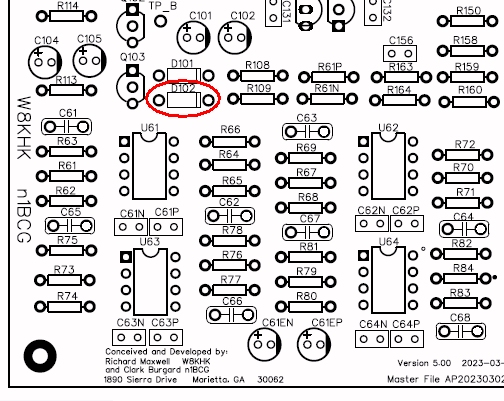 |
The dark secret of phase rotators
These all-pass filter circuits allow higher average modulation because they reduce excessive gain reduction caused by asymmetric audio.
The MAX Audio Processor utilizes an 8 pole phase rotator which provides the optimal amount of asymmetry cancellation by inverting the phase of the audio so that both lower and higher frequency asymmetry (which are typically opposite in polarity) cancel within their own frequency bands.
But what if instead of making the waveform symmetric, the asymmetric lows are inverted to match the polarity of the asymmetric highs? This would be the audio equivalent of nuclear fusion by creating "super-asymmetry" so we must handle this with care. Incredibly, a 2 pole phase rotator will do just that due to the reduced number of phase shifts.
|
For reference, here's a chart showing the 180 degree phase inversions using 8, 4, and 2 pole filters:
| Filter |
180 degree shifts (Hz) |
| 8 Pole |
78, 230, 520, 1750 |
| 4 Pole |
150, 820 |
| 2 Pole |
350 |
To do this on the MAX 500, remove ICs U61, U62, and U63 and add a jumper as shown in the image to the right (click for a larger view). |
|
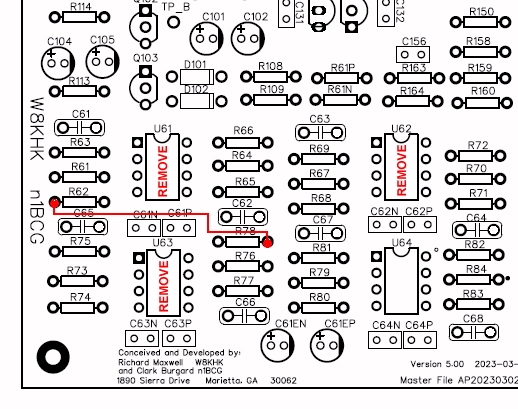 |
Continuously variable bandwidth
The earliest versions of the MAX Audio Processor had this feature although it was subsequently changed to switch-selectable presets. Being able to instantly "dial in" any bandwidth was an incredibly cool feature and made for some great on-air demonstrations but it required a calibrated dial. The option is still there and the process for converting to continuously variable bandwidth is fairly simple.
|
The board image to the right shows the locations for R123, R124, and R125 which determine the narrow, medium, and wide presets. The easiest way is to replace R125 with a 620 Ohm series resistor (or adjust the trimpot to 620 Ohms) then replace the bandwidth switch with a 10k potentiometer. This combination gives a continuously variable bandwidth range of 7.4 kHz to 18 kHz (3.7 kHz to 9 kHz frequency response). A "linear taper" is preferred over an "audio taper" potentiometer in order to have a more linear bandwidth scale on the panel.
With the bandwidth switch removed, connect the potentiometer to the center and lower circuit board holes where the switch used to be. The other end of the wires would connect to the wiper (middle terminal) on the potentiometer and one of the outer terminals. The chosen terminal will determine whether the bandwidth increases or decreases depending on the direction the knob is turned. The most common is to have bandwidth increase with a clockwise turn. Usually this would mean using the outer terminal on the right when looking at the potentiometer from the front (shaft end).
|
|
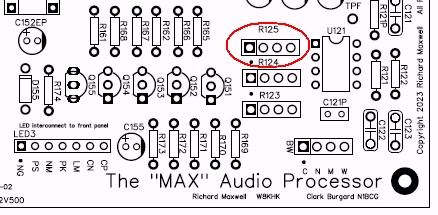
|
|
To use continuously variable bandwidth, set the panel switch to "Wide" and use the new potentiometer to set the bandwidth. A dial will be needed with appropriate markings in order to know where to set the knob for the desired bandwidth. See the "SCAF Bandwidth Filter Check" section toward the bottom of the Calibration page.
|
Low cut filter cut-off frequency (Fc) change
|
A filter's cut-off frequency (Fc) is the point along the response curve that represents 3dB of attenuation or a value of 70.7 % of the input voltage. The MAX Audio Processor uses a Sallen-Key Butterworth high pass filter with an Fc of 118 Hz and a maximum attenuation of 28 dB at 20 Hz. This curve was chosen for its effectiveness in reducing low frequency noise in broadband applications.
However, a user may want more aggressive reduction from a higher Fc when there is significant low frequency noise, limited bandwidth, or for a crisper sound. This can easily be done by replacing C21, C22, R23, and R24. The new values should be 0.047uF for both capacitors and 10k for both resistors to achieve an Fc of 450 Hz. Note that the board image shown is for the 510 series although the component numbers are the same for other revisions.
|
|
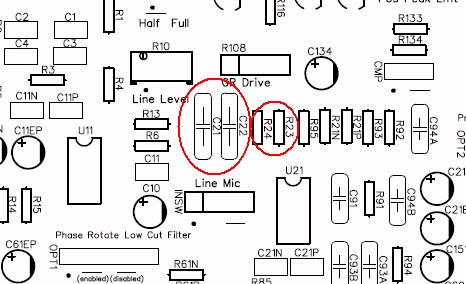
|
Deep cleaning "mud removal" filter
|
Get your QSOs their whitest with this deep-cleanse filter! Some users have mentioned needing to attenuate the "mud frequencies" in the lower-hundred Hertz range, common for those with deep voices or to counteract microphones with a lower mid-range boost.
This medium-Q twin-T filter provides: -1 dB @ 62 Hz, -3 dB @ 94 Hz, -6 dB @ 290 Hz, -3 dB @ 440 Hz, and -1 dB @ 700 Hz, all referenced to 1000 Hz. The insertion loss is 4 dB. The additional 0.2uf cap is used for shelving to flatten the gain above 1000 Hz to 0.5 dB
Ideally this should (and probably will) be placed after the phase rotator, but it can easily be added as an external circuit to the line input. For unbalanced inputs, the circuit is simply placed inline with the audio. For balanced inputs, the circuit is placed inline with the + lead and the ground (or common) connects to the - lead.
|
|
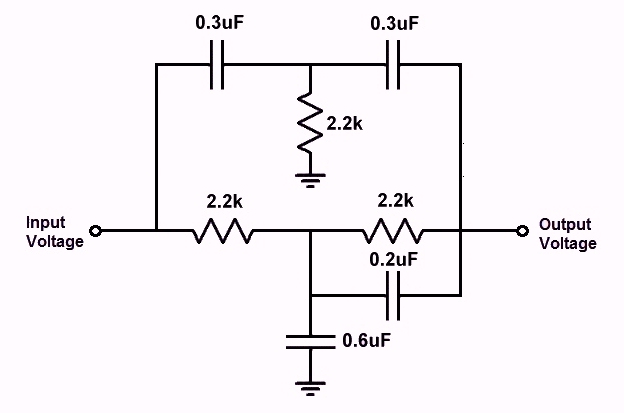
|
Ground loop hum and noise
This isn't so much of a hack as it is a suggestion for eliminating ground loop hum or other noises when connecting the MAX output to an unbalanced input, such as a microphone input. The MAX is equipped with a low level output with a D.C. blocking option for this purpose but in some cases it is not possible to connect the audio ground connection on a mic jack to the shield of the cable from the MAX without getting ground loop noise.
The circuit shown below uses an audio isolation transformer followed by an attenuator and then a D.C. blocking capacitor which will effectively couple the high level (0 dBm) balanced output of the MAX to an unbalanced microphone input.
|
The transformer (T1) can be a 600:600 or a common 1k to 8 Ohm speaker output device. For the latter, connect the full 1k primary to the balanced output of the MAX for greatest step-down attenuation. R1 can be around 22k when used with a 1:1 transformer or 2.2k if a 1k to 8 Ohm speaker transformer is used. R2 is optional and is chosen to properly load the secondary of the transformer for flattest frequency response. R3 is 180 Ohms. C1 can be between 1uF and 4.7uF at 16V and is purely for mic inputs that also have a D.C. voltage on them for powering electret microphone elements.
|
|
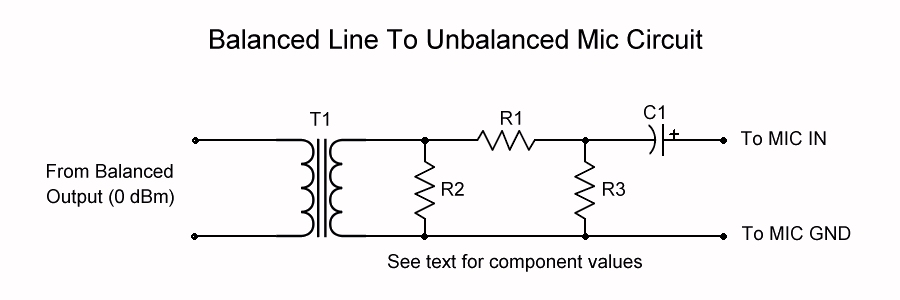
|
| The microphone gain is controlled using the adjustment on the rig just as it would be if a handheld mic were used. The balanced output of the MAX would be set for around 0 dBm but could be adjusted to match the circuit levels to typical microphone levels for each rig.
|
A Final Word regarding Customization, Troubleshooting, and Support
The Max audio processor was developed by several amateurs in spare time over the past two years, with many revisions and refinements. They have performed on-air testing, evaluated various components in the mix, and arrived at a point where it is believed that the results should be shared. If assembled as recommended in these documents, without extraneous customizations, the device should provide excellent performance. That said, the kits are being made available at cost-of-components plus just enough to recover handling, shipping, tax, etc.
Additional effort has been expended to provide as thorough documentation as possible. The kits are offered "as-is" with no implied warranty or support. With the modular interfaces, it should be very easy for any amateur to trace the signal through any of the modules, isolate problems, and identify any parts issues. Through numerous component changes, the circuit boards have stood up to extensive soldering and de-soldering without any quality issues. It is hoped that the availability of this device will bring satisfaction to the builder and pleasure in operating on the ham bands. We look forward to hearing your call and working you in the near future.
|












